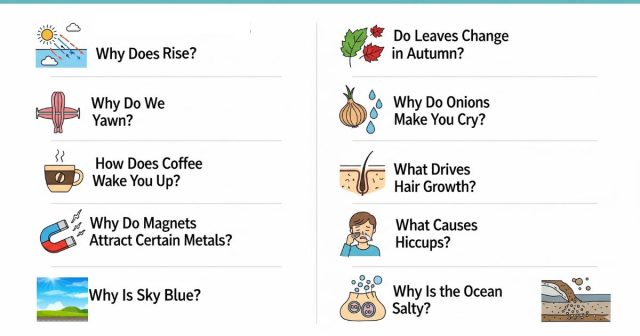Life is full of everyday phenomena that spark curiosity—from the blue sky above to the aroma of morning coffee. While these moments may seem ordinary, they carry fascinating scientific explanations that connect us to the hidden mechanics of nature. Here, we’ll break down common science questions with clear, simple explanations, helping you uncover the science facts behind daily life mysteries. Whether you’re eager to expand your knowledge, share fun trivia with friends, or simply enjoy learning the scientific reasons behind ordinary events, this guide will make the world around you even more exciting.
Why Is the Sky Blue?
On a clear day, sunlight entering Earth’s atmosphere collides with molecules and tiny particles. These collisions scatter shorter wavelengths of light, like blue and violet, more effectively than longer wavelengths. Although violet light scatters even more, our eyes are more sensitive to blue, and some violet is absorbed by the upper atmosphere. This process, known as Rayleigh scattering, fills the sky with a soft blue glow that shifts toward warmer hues near sunrise and sunset when sunlight follows a longer path through the atmosphere.

Why Do Leaves Change Color in Autumn?
During spring and summer, chlorophyll gives leaves their vibrant green hue and helps plants convert sunlight into energy via photosynthesis. As daylight hours shorten and temperatures drop in autumn, trees slow chlorophyll production. The green pigment fades, unveiling yellow and orange carotenoids that were present but masked all along. In some species, chemical changes produce red anthocyanin pigments. These combined shifts create the breathtaking tapestry of fall foliage that marks the seasonal transition.

What Causes Hiccups?
A hiccup is an involuntary contraction of the diaphragm, the muscle that separates your chest cavity from your abdomen and plays a key role in breathing. When the diaphragm spasms suddenly, the vocal cords snap shut, producing the characteristic hic sound. Common triggers include eating too quickly, consuming carbonated drinks, or sudden excitement. Most hiccup episodes are brief, but persistent hiccups can signal irritation of the phrenic nerves or underlying medical issues.
Why Do Onions Make You Cry?
Cutting an onion damages its cells, releasing a series of enzymes that convert amino acid sulfoxides into sulfenic acids. These then rearrange into syn-propanethial-S-oxide, a volatile compound that wafts toward your eyes. When it contacts the moist surface of your eyeball, it triggers sensory neurons to send a distress signal to your brain. The brain responds by producing tears to dilute and flush out the irritant, resulting in the familiar eye-watering reaction.
How Does Coffee Wake You Up?
Caffeine, the primary active ingredient in coffee, is a central nervous system stimulant. After you drink coffee, caffeine is absorbed into the bloodstream and travels to the brain. There, it blocks adenosine receptors. Adenosine is a neurotransmitter that promotes relaxation and sleepiness. By preventing adenosine from binding, caffeine keeps you alert and can even enhance mood, reaction time, and cognitive performance, at least until its effects wear off.
What Drives Hair Growth?
Hair growth occurs in cycles. The active growth phase, called anagen, can last several years as cells in the hair follicle rapidly divide. This is followed by catagen, a brief transitional phase during which growth slows and the follicle shrinks. Finally, during telogen, the hair rests before eventually falling out and allowing a new hair to begin the cycle. Genetics, hormones, nutrition, and overall health all influence the speed and density of hair growth across the scalp and body.
Why Do Magnets Attract Certain Metals?
Magnetism arises from the motion of electric charges and the intrinsic spin of elementary particles, especially electrons. In ferromagnetic materials, such as iron, cobalt, and nickel, atomic magnetic moments align within domains. When a magnet brings its field close to such materials, it encourages alignment of these domains, resulting in a net attraction. The strength of this force depends on the material properties and the distance between the magnet and the metal object.
Why Do We Yawn?
Yawning remains partly mysterious, but several theories exist. One suggests that yawning helps regulate brain temperature: the deep inhalation draws in cool air, promoting blood flow that cools the brain. Another theory connects yawning to social communication and empathy—contagious yawning may synchronize group behavior. Finally, yawning could help maintain alertness by stretching the lungs and lung tissue, increasing heart rate, and fostering arousal.
Why Does Bread Rise?
Bread dough rises thanks to the fermentation activity of yeast. Yeast cells consume sugars in the flour and release carbon dioxide and ethanol as byproducts. Tiny CO₂ bubbles become trapped in the dough’s gluten network—a web of proteins that gives bread its structure. As these bubbles expand, the dough puffs up, resulting in the light, airy texture we associate with freshly baked bread.
Why Is the Ocean Salty?
Rivers continuously erode rocks on land, carrying dissolved minerals, including sodium and chloride ions, into the oceans. Over millions of years, these ions have accumulated because the primary way water leaves the ocean—evaporation—leaves salts behind. This process has steadily increased ocean salinity, creating the roughly 3.5 percent salt concentration found in today’s seas.
Conclusion
From the color of the sky overhead to the bubbling dough beneath our hands, everyday experiences are powered by rich scientific principles. By understanding the mechanics behind these phenomena, we deepen our appreciation for the world around us and reinforce the value of lifelong learning. Next time you sip your coffee or gaze at autumn foliage, remember the remarkable science at play in the simplest of moments.
Learn More: Everyday Wonders Decoded: 12 Fascinating Insights You Never Knew









